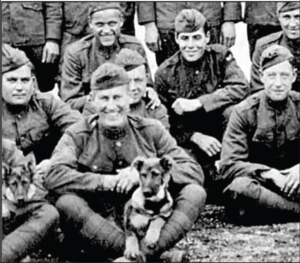
Rin Tin Tin, center and his sister, Nanette, soon after they were rescued from a bombed out kennel in France. His grandson, Rin III, helped train about 5,000 dogs for wartime service in WWII.
March 13 is recognized as National K9 Veterans Day, the official birthday of the US Army K9 Corps, which was formed in 1942. Joseph White, a retired military working dog trainer, originated the idea.
Many things changed after the bombing of Pearl Harbor in 1941. We rationed oil, leather and rubber. The military drafted men into service. Women rolled up their sleeves and built war supplies. And dogs were called to duty.
During World War I, the United States had taken notice of the European use of canines as sentries, message carriers and several other functions.
A private citizen, Alene Erlanger, initiated a program called Dogs for Defense. Along with the American Kennel Club and a handful of breeders, the group aimed to train the dogs for military use. By November 1942, the military prepared the first Dogs for Defense for duty in North Africa.
As the war progressed, Dogs for Defense was unable to keep up with the demand, and the Remount Branch, Service Installations Divisions took over the dog training.
Over the years, the military, police, and rescue organizations have developed a variety of training methods for K9 units tailored to meet the demands of the specific job.
Famous War Dogs
The most famous dog to emerge from World War I was Rin Tin Tin, an abandoned puppy found in France in 1918 and taken to the United States, where he made his film debut in the 1922 silent film The Man from Hell’s River. As the first bona fide animal movie star, Rin Tin Tin made the little-known German Shepherd breed famous across the country.
The top canine hero of World War II was Chips, a German Shepherd/Collie/Husky mix donated by the Wren family of Pleasantville, N.Y., through the Dogs for Defense program. Trained as a sentry dog at the Dog Training Center in Front Royal, Va., Chips served with the Army’s 3rd Infantry Division throughout the war, and was one of three dogs on duty when President Roosevelt met with Winston Churchill at Casablanca in 1943. Chips saw action near Licata, Sicily, when he broke away from his handlers and attacked an enemy machine gun nest, forcing the entire 10-member crew to surrender.
At the war’s end Chips, honorably discharged, returned to the Wren family in Dec. 1945.
